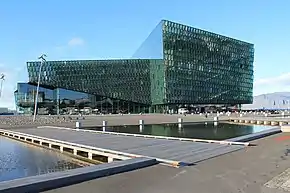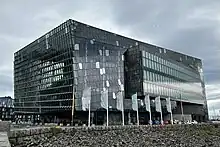Harpa (concert hall)
Harpa (Icelandic pronunciation: [ˈhar̥pa], English: Harp) is a concert hall and conference centre in Reykjavík, Iceland. The opening concert was held on May 4, 2011. The building features a distinctive colored glass facade inspired by the basalt landscape of Iceland.[2]
| Harpa Concert Hall and Conference Centre | |
|---|---|
Harpa, tónlistar- og ráðstefnuhús | |
 Harpa | |
| General information | |
| Type | Concert hall & conference centre |
| Location | Reykjavík, Iceland |
| Address | Austurbakki 2 |
| Town or city | Reykjavík |
| Country | Iceland |
| Coordinates | 64°9′1″N 21°55′57″W |
| Current tenants | Iceland Symphony Orchestra The Icelandic Opera The Reykjavík Big Band Maximus Musicus |
| Construction started | January 12, 2007 |
| Completed | 2011 |
| Opened | May 13, 2011 |
| Cost | €164 million[1] |
| Owner | Portus |
| Height | 43 metres (141 ft) |
| Technical details | |
| Floor area | 28,000 square metres (300,000 sq ft) |
| Design and construction | |
| Architecture firm | Henning Larsen Architects Batteríið |
| Other designers | Olafur Eliasson, facade design Artec Consultants, acoustics design |
| Main contractor | ÍAV |
| Other information | |
| Seating capacity | 1,600–1,800 (Eldborg, main hall) 450 (Norðurljós) 750 (Silfurberg) 195 (Kaldalón) |
| Website | |
| Venue website | |
History
Harpa was designed by the Danish firm Henning Larsen Architects in co-operation with Danish-Icelandic artist Olafur Eliasson. The structure consists of a steel framework clad with geometric shaped glass panels of different colours.[3][4] The building was originally part of a redevelopment of the Austurhöfn area dubbed World Trade Center Reykjavík, which was temporarily abandoned when the 2008 Icelandic financial crisis took hold. The development was originally intended to include a 400-room hotel, luxury apartments, retail units, restaurants, a car park and the new headquarters of Icelandic bank Landsbanki. These related developments were put on hold, but resumed construction by 2018 and as of 2022, the development is almost complete. The Reykjavik Edition Hotel, managed by Marriott International opened in 2021 along with retail and restaurant units; Landsbankinn is projected to move into their newly constructed headquarters in early 2023.[5][6][7]

Construction started in 2007 but was halted with the start of the financial crisis.[2] The completion of the structure was uncertain until the government decided in 2008 to fully fund the rest of the construction costs for the half-built concert hall. For several years it was the only construction project in existence in Iceland.[2] The building was given its name on the Day of Icelandic Music on 11 December 2009, prior to which it was called Reykjavík Concert Hall and Conference Centre (Icelandic: Tónlistar- og ráðstefnuhúsið í Reykjavík). The building is the first purpose-built concert hall in Reykjavík and it was developed in consultation with artistic advisor Vladimir Ashkenazy and international consultant Jasper Parrott of HarrisonParrott.[8] It houses the Iceland Symphony Orchestra and the offices of The Icelandic Opera.
In the opening concert on 4 May 2011, Iceland Symphony Orchestra performed under the baton of Vladimir Ashkenazy with the Icelandic pianist Víkingur Ólafsson as soloist.[9] The concert was broadcast live on RÚV, the Icelandic National Broadcasting Service.[10] In the water next to Harpa is located the sculpture The Musician (1970) by the Icelandic sculptor Ólöf Pálsdóttir. The statue is of a cellist playing, and is modelled on the Danish cellist Erling Blöndal Bengtsson, who played constantly for Ólöf as he sat for her.[11] When the Orchestra was based at its previous home at the Háskólabíó, the statue was located on Hagatorg, but it followed the Orchestra in 2014.[12]
The Icelandic Opera performs at the concert hall even though the venue is primarily designed for concerts, lacking a curtain, proscenium, and any of the traditional stage machinery.[13] The first director of Harpa was Halldór Guðmundsson.[14] The current director of Harpa is Svanhildur Konráðsdótir. Harpa is operated by Portus, a company owned by the Icelandic government and the City of Reykjavík.
In 2013, the building won the European Union's Mies van der Rohe award for contemporary architecture.[2] In 2017, the venue held the annual World Yo-Yo Contest, where over a thousand contestants from over 30 countries competed for the six champion titles. It was only the second time ever the contest was held in Europe.[15]
Appearances in popular culture
In its unfinished state, Harpa (under the earlier name Tónlistarhús) appears in Gæska: Skáldsaga by Eiríkur Örn Norðdahl, where it is temporarily turned into a mosque with the addition of a minaret.
It was the setting of an episode of the Netflix series Sense8.
It appeared in the Netflix series Black Mirror on the episode "Crocodile".
It's the site of the "rose ceremony from hell" in Clayton's season of The Bachelor from 2022.
References
- MacKin, Laurence. "Iceland opens stunning new arts centre in the teeth of a recession". The Irish Times. Retrieved 14 December 2011.
- "Harpa in Reykjavik: Iceland's symbol of recovery". Nordiclabourjournal.org. 17 June 2014. Retrieved 25 March 2015.
- Gibberd, Matt; Hill, Albert (20 August 2013). "The Return of Ornamentation". The Daily Telegraph. London. Archived from the original on 18 October 2014. Retrieved 12 October 2015.
- "Harpa Concert and Conference Centre Reykjavik by Henning Larsen Architects". de zeen magazine. 29 August 2011. Retrieved 7 November 2015.
- "Austurhöfn tekur á sig mynd". www.vb.is. Retrieved 2022-12-07.
- 'Opna lúxushótel við Hörpu 2018', Viðskiptablaðið (14 April 2015).
- "Luxury Hotel Expects Busy Summer". Iceland Monitor. Retrieved 2022-12-07.
- http://art4logic.blogspot.co.uk/2012/05/harpa-conference-center-opera-in.html%5B%5D
- McManus, David. "Harpa: Reykjavik Building, Iceland". e-architect.co.uk. Retrieved 11 November 2016.
- "Press Release: Harpa Reykjavik Concert Hall and Conference Centre Official Opening on 4 May 2011" (PDF). Morgunblaðið. Retrieved 11 November 2016.
- "The Reykjavík Grapevine: The Statue Walk Around Reykjavík". Retrieved 19 December 2020.
- "Statue of cellist Erling Blöndal Bengtsson to be moved to Harpa". Iceland Magazine. 14 April 2014. Retrieved 19 December 2020.
- Shirley, Hugo (2012-03-19). "La bohème, Icelandic Opera, Reykjavik, review". The Daily Telegraph. London. ISSN 0307-1235. Retrieved 2018-01-18.
- "Harpa Official Website – Staff". www.harpa.is. Retrieved 11 November 2016.
- "International Yo-Yo Federation". iyyf.org. Retrieved 4 November 2022.